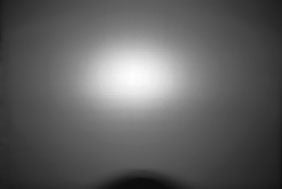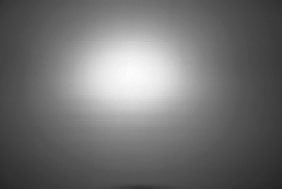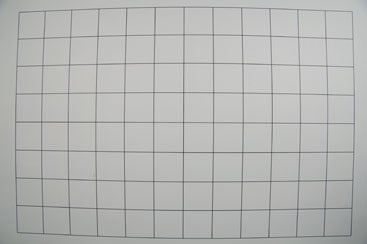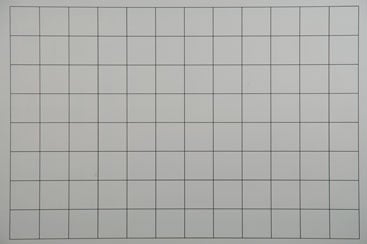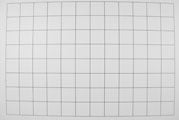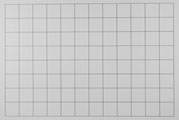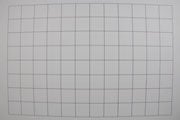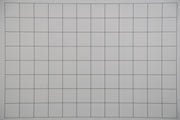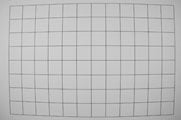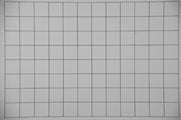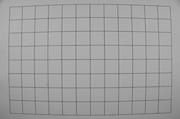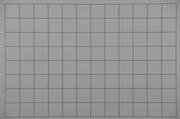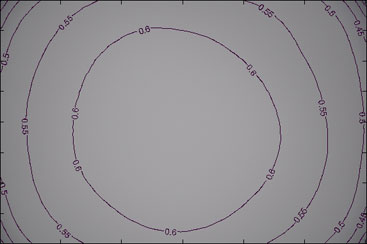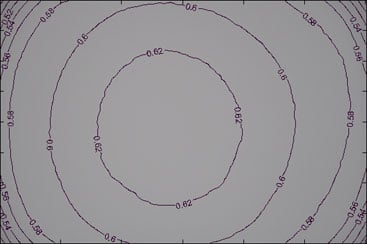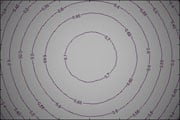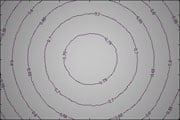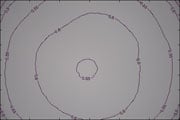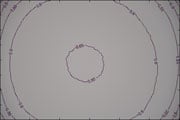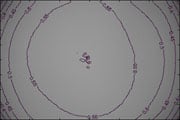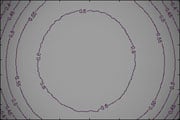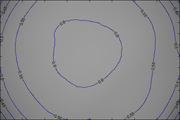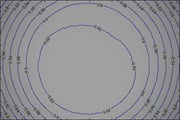Nikkor AF-S DX 16-85mm f/3.5-5.6G ED VR
-
-
Written by Gordon Laing
Quality
Nikkor DX 16-85mm VR design and build quality
The Nikkor DX 16-85mm VR is pictured below on the left, with the DX 18-105mm VR kit lens and 14-24mm professional ultra-wide angle to its right. Measuring 85mm in length and with a maximum diameter of 72mm, the DX 16-85mm VR is actually a little narrower and shorter than the 89x76mm of the DX 18-105mm VR kit lens, although both are dwarfed by the 14-24mm with its 98mm length and 132mm diameter built-in hood. For reference, the popular DX 18-200mm VR super- zoom measures 97x77mm.
In terms of physical styling and design, the DX 16-85mm VR certainly looks very similar to the DX 18-105mm VR kit lens, although there are several key differences. Most obviously the DX 16-85mm VR features a shorter zoom ring to make room for the focus distance window – a feature you won’t find on any of Nikon’s kit lenses.In terms of weight, the DX 16-85mm VR comes in at 485g, so is a little heavier than the 420g of the DX 18-105mm VR kit lens and a little lighter than the 560g of the DX 18-200mm VR, although again unsurprisingly all fall well below the 970g heft of the 14-24mm. So with a similar size and weight to Nikkor’s latest kit lens, the DX 16-85mm VR won’t feel out of place to most owners.
The manual focusing rings felt similar on the DX 16-85mm VR and DX 18-105mm VR, although the zoom ring on the former was stiffer on our sample despite roughly the same degree of usage. Unlike the plastic mountings on most kit lenses, the DX 16-85mm VR employs a metal fitting and there’s also a rubber ring for environmental sealing.
Ultimately the DX 16-85mm VR felt solid and confident in use, but while aspects like the metal mounting and rubber sealing physically represent a step-up from Nikkor’s kit lenses, don’t expect a difference of night-and-day in your hands as models like the DX 18-105mm VR are also fairly well-built. For a more significant difference in build and handling, you’ll need to go to a pro model like the 14-24mm.
As you zoom-in, the barrel on the DX 16-85mm VR extends in two sections by 42mm. Thanks to the relatively short extension, light internal elements and stiff zoom ring, we didn’t experience any creep with the lens, and it’s unlikely to be an issue in the future. Finally, like most Nikkor lenses, the DX 16-85mm VR is supplied with a lens hood (are you listening Canon?)
| |||||||||||
A quick note about using the popup flash with the DX 16-85mm VR. We tried it without a lens hood using the Nikon D60 and found a small shadow was cast by the lens barrel when fully zoomed-out. This gradually becomes less visible as you zoom-in, and by 20mm it’s virtually gone. It’s less of an issue on bodies with higher popup flashes. Many thanks to Ernie Cabbagio who assisted with this test.
Nikkor DX 16-85mm VR optical design notes
The Nikkor DX 16-85mm VR employs 17 elements in 11 groups, with two ED glass elements and three aspherical lenses. The focal ratio is the usual f3.5 when zoomed-out to 16mm and f5.6 when zoomed-into 85mm, and the aperture employs seven rounded blades; in terms of focal ratio and aperture blades, it’s the same as the DX 18-105mm VR kit lens. The closest focusing distance is 38cm throughout the focal range and we have a macro example in our sample images gallery.
Nikkor DX 16-85mm VR focusing
Towards the mounting end of the lens barrel you’ll find a relatively thin manual focusing ring – this is identical in style and position to that on the DX 18-105mm VR kit lens, although here you have the benefit of a focus distance window above it.
A switch on the side of the barrel sets the lens between Manual focus and AF with full-time Manual over-ride – if using the latter, you can grab and turn the focusing ring whenever you wish to make adjustments, or of course half-press the shutter release on the camera body to autofocus.
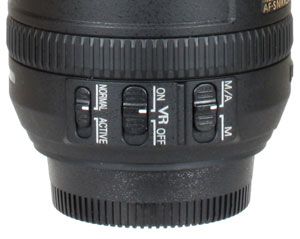 |
As an AF-S model, the DX 16-85mm VR features a built-in Silent Wave Motor (SWM) which means it’ll autofocus with any Nikon body including those which do not have built-in focusing motors of their own – such as the D40, D40x and D60 models. Focusing takes place internally and doesn’t rotate the front section nor any controls which is good news for owners of directional filters like polarisers; note the filter thread is the same 67mm diameter as the DX 18-105mm VR kit lens, making both slightly smaller than the 72mm thread of the DX 18-200mm VR.
In our tests, the DX 16-85mm VR’s SWM focusing motor was fractionally quicker than that on the DX 18-105mm VR kit lens, but both were still fairly leisurely in speed, especially when focusing from one end of the range to the other. Both models were pretty quiet while focusing, swapping the audible gearing of older (or cheaper) models for something between a faint hiss and a squeek; if you already own an AF-S DX model, you’ll know what we mean, and you can hear how it sounds for yourself in our video tour.
It should however be noted that like Canon’s USM focusing motors, not all Nikkor SWM systems are equal in noise and speed. Switch to a pro model like the Nikkor 14-24mm f2.8 and you’ll notice the focusing is much faster and quieter still. Either way though we have no real complaints with the DX 16-85mm VR’s focusing, but don’t buy this lens hoping for much faster or quieter performance than models like the DX 18-105mm VR – it’s only fractionally superior in these respects.
Now let’s take a look at the coverage and stabilisation in our Nikkor DX 16-85mm VR features page.
Nikkor DX 16-85mm VR coverage
The Nikkor DX 16-85mm VR is designed as a general-purpose walk-around lens with a range that goes from decent wide-angle to short telephoto. With the 1.5x field-reduction of Nikon’s DX-format DSLRs, the DX 16-85mm VR delivers equivalent coverage of 24-128mm. To illustrate this range in practice we mounted the lens on a Nikon D90 body, attached it to a tripod and shot the same scene fully zoomed-out, then fully zoomed-in.
Nikkor DX 16-85mm VR coverage | ||
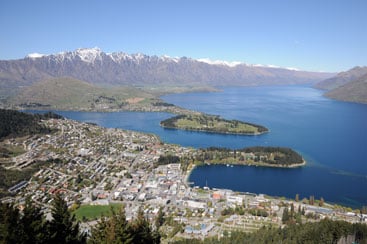 | 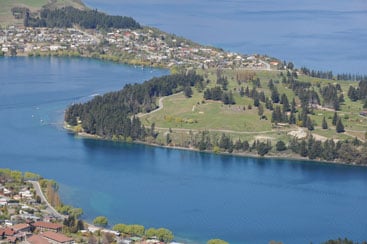 | |
DX 16-85mm VR at 16mm (24mm equivalent) | DX 16-85mm VR at 85mm (128mm equivalent) | |
The shots above illustrate the useful general-purpose range of the DX 16-85mm VR, capturing a large field-of-view when zoomed-out and delivering tighter detail when zoomed-in. If you’re buying a Nikon body only, it’s an ideal first lens, but the big question for owners of existing Nikkor general-purpose lenses is whether this range is more useful than what they already have.
The DX 16-85mm VR zooms both wider and longer than the DX 18-55mm VR kit lens supplied with the entry-level Nikon bodies, along with the earlier Nikkor DX 18-70mm. With these lenses, the coverage benefits of the DX 16-85mm VR are obvious, but compare it to Nikons other kit lenses and you’ll find both pros and cons to the range.
The D80 and D90 bodies were typically bundled with the DX 18-135mm and DX 18-105mm VR kit lenses, which may not zoom as wide as the DX 16-85mm VR, but both zoom-in noticeably further. This makes ‘upgrading’ from one of these to the DX 16-85mm VR a bitter-sweet experience which gains at the wide-end but loses out on the telephoto.
It should be clear by now the major differentiator between the DX 16-85mm VR and the other Nikkor general-purpose lenses (including the DX 18-200mm VR) is its wider-angle coverage of 24mm equivalent, so the question you have to ask yourself is just how much you want or need it – and if so, whether you’d be better off having it in a general-purpose lens, or an ultra-wide model like the Nikkor DX 12-24mm.
But what’s the big deal about 24mm coverage anyway? If you’ve not used a 24mm equivalent lens before, it may not sound a great deal different from 28mm, but in practice it actually delivers a comfortably wider field-of-view that’s preferred by many. Indeed the 24-120 (ish) mm range is considered by many to be perfect for a general-purpose walk-around lens, and you’ll find equivalent models for most brands, including the Sony 16-80mm (24-120mm equiv), Olympus 12-60mm (24-120mm equiv) and the Canon 24-105mm (equiv to 24-105mm on full-frame bodies only); interestingly Canon doesn’t yet have a 24-120mm equivalent range for its EF-S bodies. So the Nikkor DX 16-85mm VR may deliver ‘ideal’ coverage, but again the question is whether it’s sufficiently compelling compared to alternative Nikkor general-purpose lenses.
Nikkor DX 16-85mm VR stabilisation
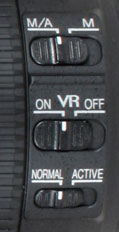 |
The Nikkor DX 16-85mm VR is equipped with Vibration Reduction capabilities to counteract camera-shake. Like all of Nikkor’s VR lenses to date, this employs an optical system which means you see the stabilising effect while composing through the optical viewfinder. Seeing the image suddenly steady itself when you half-press the shutter release button is very reassuring, especially when you’re shooting at longer focal lengths. VR version II is implemented on this lens, which Nikon claims is good for up to four stops of compensation.
A switch on the side of the lens barrel allows you to set the VR on or off, while a second switches between Normal or Active modes. Active mode is designed for shooting from moving vehicles; we used Normal during our handheld tests. To put its effectiveness to the test we took a series of photos with the lens zoomed-into 85mm where it was working at an equivalent of 128mm and traditional photographic advice would recommend a shutter speed of at least 1/125 to eliminate camera shake.
Our sequence therefore started at 1/125 and reduced by one stop each time until 1/2. We performed this sequence twice, first without VR enabled, and secondly with VR enabled in Normal mode. Below are 100% crops taken from the non-VR and VR images at a shutter speed of 1/15.
Nikkor DX 16-85mm VR Vibration Reduction off / on (Normal mode) | ||
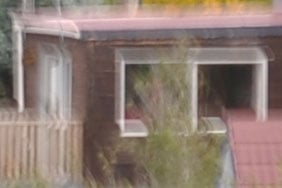 |  | |
100% crop, DX 16-85mm VR at 85mm, 1/15, VR off | 100% crop, DX 16-85mm VR at 85mm, 1/15, VR on | |
Under the conditions of the day, the slowest shutter speed we could handhold the lens fully zoomed-in without any stabilisation was 1/125; anything slower resulted in visible camera-shake. With VR enabled though, we could match the sharpness under the same conditions at a shutter speed of 1/15. You can see examples taken at 1/15 with and without stabilisation above, and it’s clear how the version with VR is much steadier.
This corresponds to three stops in practice over our 1/125 shot. So while we didn’t quite achieve the claimed four stops in person, having three at your disposal is still very respectable and makes the DX 16-85mm VR usable in a variety of environments even when fully zoomed-in. Just remember though, Vibration Reduction cannot do anything about freezing a subject in motion – for that you’ll simply need a sufficiently quick shutter speed.
Now it’s time to see how the lens performs against alternative general purpose zooms in our Nikkor DX 16-85mm VR results pages.
Real-life resolution – Nikkor DX 16-85mmm VR vs DX 18-105mm VR vs 14-24mm f2.8
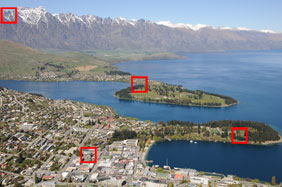 | |
To compare real-life performance we shot this scene with the Nikkor DX 16-85mm VR, DX 18-105mm VR and 14-24mm f2.8, all mounted on the same Nikon D90 body within moments of each other. The lenses were adjusted to deliver the same field of view, and set to f8 in Aperture Priority. VR was disabled on lenses with the facility. The D90 was set to its base sensitivity of 200 ISO and into RAW mode to avoid in-camera JPEG corrections; all files were processed in Nikon Capture NX2 with lens corrections disabled.
The image above was taken with the Nikkor DX 16-85mm VR mounted on the Nikon D90 body. The lens was set to 24mm f8, and the D90 set to 200 ISO. The exposures were identical with each lens (1/640 at f8) and the crops are taken from the areas marked with a red square above, and are presented here at 100%.
Nikon’s latest DSLRs feature very effective in-camera reduction of coloured fringing, and if we were comparing in-camera JPEGs, the first row of crops would have looked almost identical. To avoid digital corrections and tell the true story though, our latest lens tests compare images shot in RAW and converted without any lens corrections enabled.
So like most lenses, when faced with a high-contrast subject near the corner of their frames, all three are suffering to some degree from coloured fringing. The DX 18-105mm VR kit lens unsurprisingly shows the worst fringing of the three, followed by the professional 14-24mm, with the DX 16-85mm VR coming in just ahead. It’s not a huge lead for the DX 16-85mm VR though, but worth mentioning it and the 14-24mm are also exhibiting slightly higher contrast than the kit lens in this row. Note: the coloured fringing disappeared when comparing in-camera JPEGs, or RAW files processed in Capture NX2 with corrections enabled.
Moving onto the second row of crops taken from an area near to the centre of the frame, all three lenses are delivering roughly the same amount of real-life detail on the D90, although the 14-24mm is again showing slightly higher contrast.
The third row of crops, taken from an area towards the lower right of the frame, however shows some quite apparent differences in optical quality. The professional grade 14-24mm is comfortably sharper than the crops from the other two lenses, although this is expected considering its price and the fact it’s corrected for a larger full-frame sensor. As for the two DX models, the 18-105mm VR kit lens is a little softer in this region than the DX 16-85mm VR.
Moving onto the fourth and final row of crops, there’s little to choose between any of the three lenses. The 14-24mm again shows slightly greater contrast and avoids the tiny amount of fringing around the white arches on the middle building, but both are minimal issues here and the real-life detail recorded with the D90 is essentially the same.
So as you might expect, the DX 16-85mm VR comes ahead of the DX 18-105mm VR kit lens in this test, but falls behind the professional 14-24mm model. But the DX 18-105mm VR is performing well for a kit lens, and there’s only a minor quality benefit enjoyed by the DX 16-85mm VR over it here.
We have further real-life comparisons though at their shortest and longest focal lengths and at wider apertures, so to see how the lenses measure-up under these conditions, let’s move onto our Real-life Corner sharpness results.
Nikkor DX 16-85mm VR with Nikon D90 | Nikkor DX 18-105mm VR with Nikon D90 | Nikkor 14-24mm f2.8 with Nikon D90 | ||
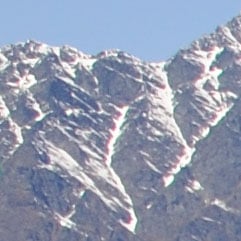 | 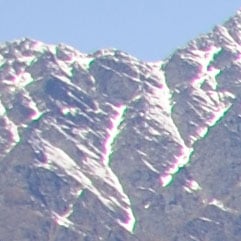 | 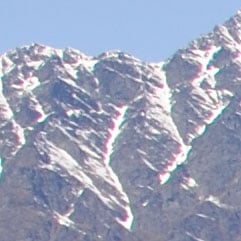 | ||
f8, 200 ISO | f8, 200 ISO | f8, 200 ISO | ||
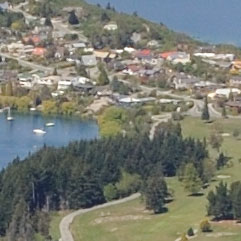 | 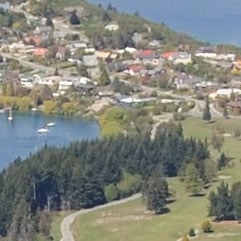 | 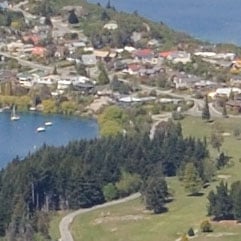 | ||
f8, 200 ISO | f8, 200 ISO | f8, 200 ISO | ||
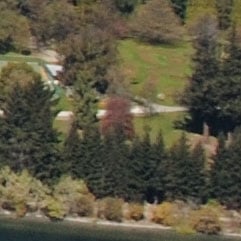 | 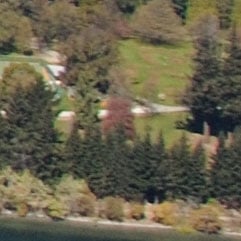 | 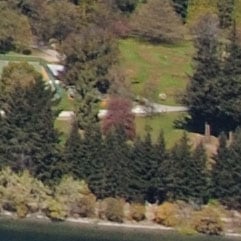 | ||
f8, 200 ISO | f8, 200 ISO | f8, 200 ISO | ||
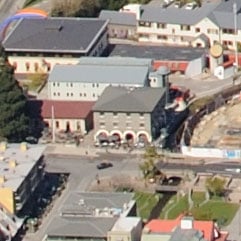 | 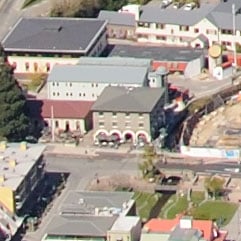 | 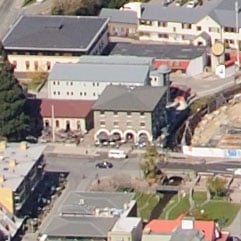 | ||
f8, 200 ISO | f8, 200 ISO | f8, 200 ISO |
Real-life wide-angle sharpness at 16mm – Nikkor DX 16-85mm VR
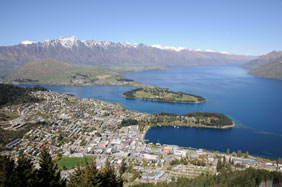
To compare real-life corner sharpness when zoomed-out, we shot this scene with the Nikkor DX 16-85mm VR on the Nikon D90 body. The DX 16-85mm VR was zoomed-out to its shortest 16mm focal length and tested at all aperture settings with VR disabled. The D90 was set to its base sensitivity of 200 ISO and into RAW mode to avoid in-camera JPEG corrections; all files were processed in Nikon Capture NX2 with lens corrections disabled.
The image above was taken with the Nikkor DX 16-85mm VR mounted on the Nikon D90 body. The lens was set to 16mm f8, and the D90 set to 200 ISO. The crops are taken from the lower right corner and the centre, and presented here at 100%.
The crops from the bottom right corner of the frame show some softness, and inevitably some geometric distortion too, but we’ve seen worse from other lenses, even on crops taken further from the corner. If you scroll down to the bottom of the page you’ll see results taken from the corner of a wide angle frame using the DX 18-105mm VR kit lens, and while it’s not bad for its class, the DX 16-85mm VR is visibly superior.
Closing the aperture doesn’t make much difference to the corner sharpness of the DX 16-85mm VR when zoomed-out, but it can certainly benefit areas closer to the middle. The centre crop from the f5.6 sample is noticeably sharper than those taken at f4 or the maximum f3.5 aperture. The crop at f8 looks pretty much the same as the f5.6 sample, but you may wish to perform additional tests to see if one represents a better sweet-spot at this focal length.
To see how the DX 18-105mm VR compared when zoomed-out, scroll down, or if you’ve seen enough, head over to our Nikkor DX 16-85mm VR Real life corner results at telephoto.
Nikkor DX 16-85mm VR with Nikon D90 Wide (16mm) corner | Nikkor DX 16-85mm VR with Nikon D90 Wide (16mm) centre | |
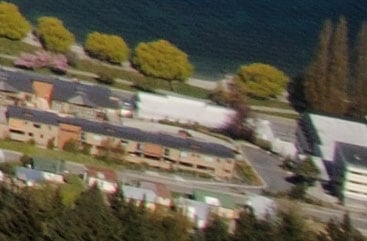 | 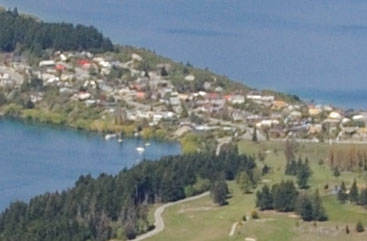 | |
f3.5, 200 ISO | f3.5, 200 ISO | |
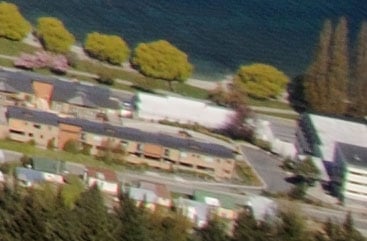 | 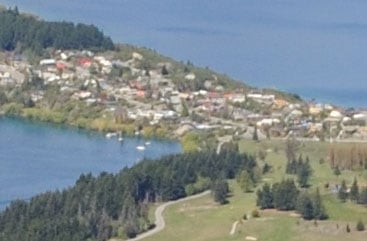 | |
f4, 200 ISO | f4, 200 ISO | |
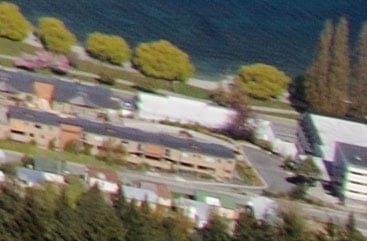 | 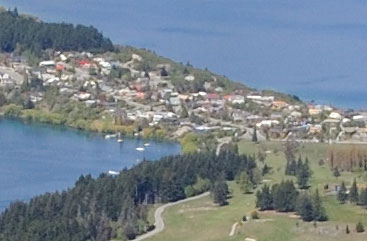 | |
f5.6, 200 ISO | f5.6, 200 ISO | |
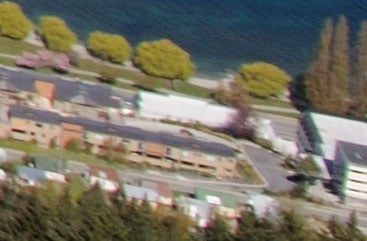 | 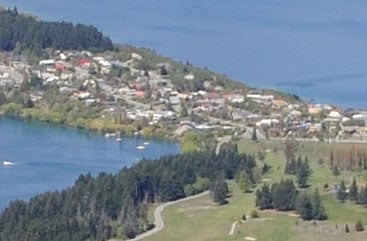 | |
f8, 200 ISO | f8, 200 ISO | |
Real-life wide-angle sharpness at 18mm – Nikkor DX 18-105mm VR
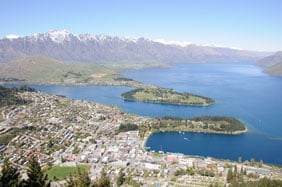
To compare real-life corner sharpness when zoomed-out, we shot this scene with the Nikkor DX 18-105mm VR on the Nikon D90 body. The DX 18-105mm VR was zoomed-out to its shortest 18mm focal length and tested at all aperture settings with VR disabled. The D90 was set to its base sensitivity of 200 ISO and into RAW mode to avoid in-camera JPEG corrections; all files were processed in Nikon Capture NX2 with lens corrections disabled.
The image above was taken with the Nikkor DX 18-105mm VR mounted on the Nikon D90 body. The lens was set to 18mm f8, and the D90 set to 200 ISO. The crops are taken from the lower left corner and the centre, and presented here at 100%.
Like most lenses, the DX 18-105mm VR suffers from some softening in the corners, and here it’s a little worse than that seen above with the DX 16-85mm VR – although it should be said it’s not bad considering it’s a kit lens. Stopping down to f8 slightly improves the situation in the corners, but not hugely.
Interestingly while the DX 16-85mm VR benefitted from stopping down to improve the sharpness of crops taken from the centre of its images, the DX 18-105mm VR performs remarkably well across its aperture range. Even when wide open at f3.5, the centre crop from the DX 18-105mm VR looks pretty respectable here, so a good result for the kit lens.
As always, the results here just represent one part of the story though, so to see how the lenses compare when zoomed-in, head-on over to our Nikkor DX 16-85mm VR Real life corner results at telephoto.
Nikkor DX 18-105mm VR with Nikon D90 Wide (18mm) corner | Nikkor DX 18-105mm VR with Nikon D90 Wide (18mm) centre | |
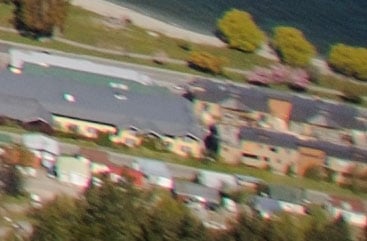 | 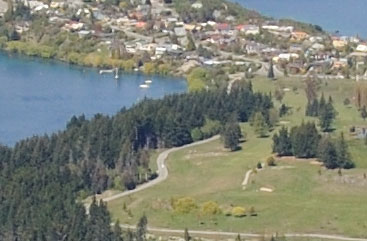 | |
f3.5, 200 ISO | f3.5, 200 ISO | |
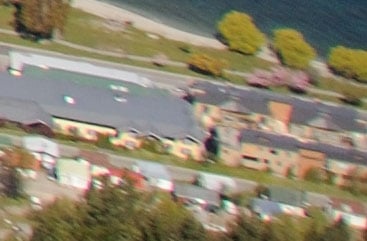 | 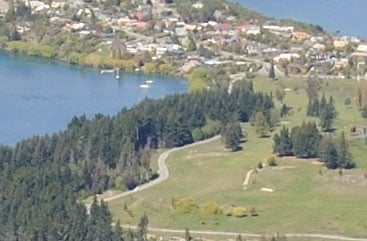 | |
f4, 200 ISO | f4, 200 ISO | |
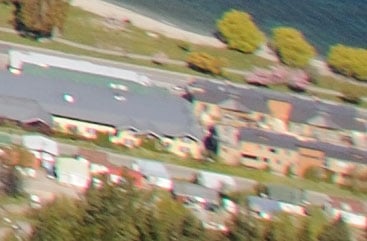 | 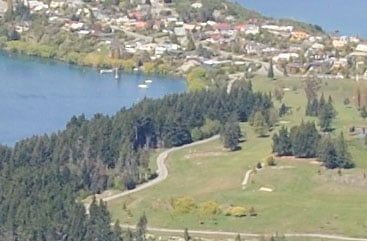 | |
f5.6, 200 ISO | f5.6, 200 ISO | |
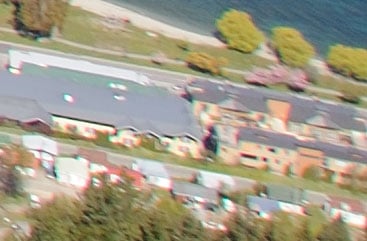 | 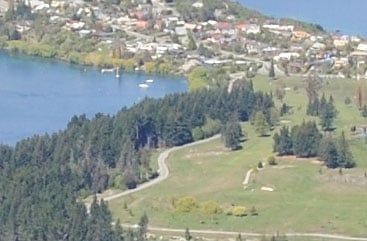 | |
f8, 200 ISO | f8, 200 ISO |
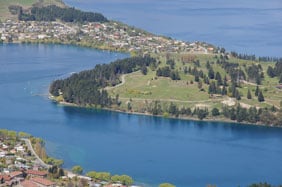 To compare real-life corner sharpness when zoomed-in, we shot this scene with the Nikkor DX 16-85mm VR on the Nikon D90 body. The DX 16-85mm VR was zoomed-into its longest 85mm focal length and tested at all aperture settings with VR disabled. The D90 was set to its base sensitivity of 200 ISO and into RAW mode to avoid in-camera JPEG corrections; all files were processed in Nikon Capture NX2 with lens corrections disabled.The image left was taken with the Nikkor DX 16-85mm VR mounted on the Nikon D90 body. The lens was set to 85mm f8, and the D90 set to 200 ISO. The crops are taken from the lower left corner and the centre, and presented here at 100%.
To compare real-life corner sharpness when zoomed-in, we shot this scene with the Nikkor DX 16-85mm VR on the Nikon D90 body. The DX 16-85mm VR was zoomed-into its longest 85mm focal length and tested at all aperture settings with VR disabled. The D90 was set to its base sensitivity of 200 ISO and into RAW mode to avoid in-camera JPEG corrections; all files were processed in Nikon Capture NX2 with lens corrections disabled.The image left was taken with the Nikkor DX 16-85mm VR mounted on the Nikon D90 body. The lens was set to 85mm f8, and the D90 set to 200 ISO. The crops are taken from the lower left corner and the centre, and presented here at 100%.With the DX 16-85mm VR zoomed-into its maximum focal length of 85mm, there’s a little softness in the extreme corners, but again it’s not bad at all. Stopping the aperture down to f8 slightly improves the situation, resolving finer detail in the extreme corners, and becoming well-corrected just a little further into the frame.
The crops taken from the centre of the image look fine here, although again there’s a small boost in ultimate fine detail with the aperture closed to f8. Scroll down to see how the DX 18-105mm VR kit lens compares when it’s also zoomed-in, or see how they measure-up in controlled conditions in our Nikkor DX 16-85mm VR studio resolution test page.
Nikkor DX 16-85mm VR with Nikon D90 Telephoto (85mm) corner | Nikkor DX 16-85mm VR with Nikon D90 Telephoto (85mm) centre | |
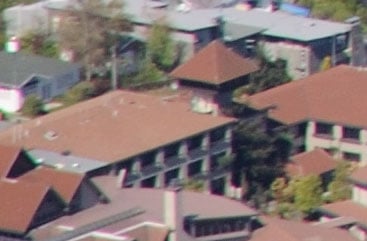 | 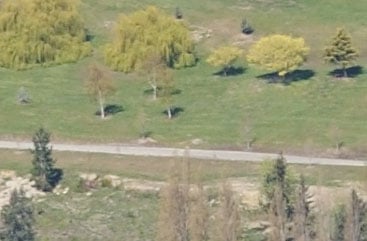 | |
f5.6, 200 ISO | f5.6, 200 ISO | |
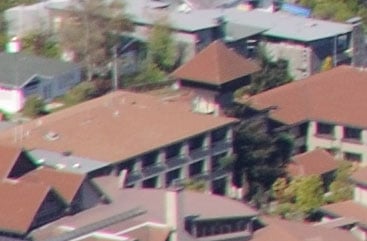 | 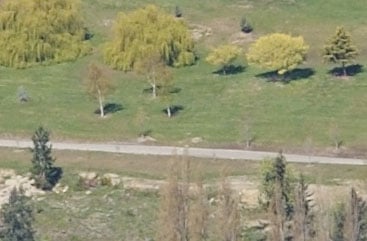 | |
f8, 200 ISO | f8, 200 ISO | |
Real-life telephoto sharpness at 105mm – Nikkor DX 18-105mm VR
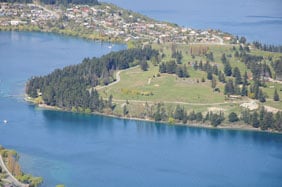
To compare real-life corner sharpness when zoomed-in, we shot this scene with the Nikkor DX 18-105mm VR on the Nikon D90 body. The DX 18-105mm VR was zoomed-into its longest 105mm focal length and tested at all aperture settings with VR disabled. The D90 was set to its base sensitivity of 200 ISO and into RAW mode to avoid in-camera JPEG corrections; all files were processed in Nikon Capture NX2 with lens corrections disabled.
The image above was taken with the Nikkor DX 18-105mm VR mounted on the Nikon D90 body. The lens was set to 105mm f8, and the D90 set to 200 ISO. The crops are taken from the lower left corner and the centre, and presented here at 100%.
With the DX 18-105mm VR kit lens zoomed-into its maximum focal length of 105mm, there’s again some softness in the extreme corners, although again impressively for its class, it’s not bad – certainly there’s little obvious benefit to the DX 16-85mm VR here.
Closing the aperture from f5.6 to f8 doesn’t improve the sharpness of the DX 18-105mm VR corner crops, although it does reduce the vignetting which in turn makes the f8 crop look a little brighter.
The crops taken from the centre of the image are both detailed, although stopping-down to f8 has slightly improved the contrast and is the preferred setting for this lens when zoomed-in.
Now let’s see how they compare under controlled conditions, in our Nikkor DX 16-85mm VR studio resolution page.
Nikkor DX 18-105mm VR with Nikon D90 Telephoto (105mm) corner | Nikkor DX 18-105mm VR with Nikon D90 Telephoto (105mm) centre | |
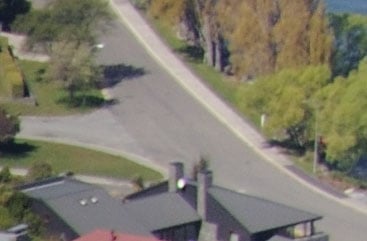 |  | |
f5.6, 200 ISO | f5.6, 200 ISO | |
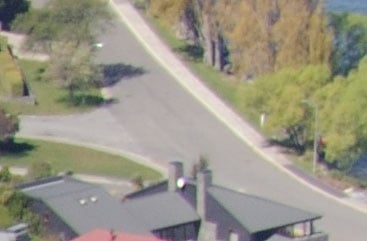 |  | |
f8, 200 ISO | f8, 200 ISO |
Studio resolution: Nikkor DX 16-85mm VR using Nikon D90
To measure and compare the Nikkor DX 16-85mm VR’s resolving power, we photographed the Enhanced Digital Camera Resolution Chart with it and the DX 18-105mm VR, each set to 35mm f8 using a Nikon D90 in Aperture Priority mode. Magnified assistance in Live View was used to confirm the focusing and VR was disabled.
The D90 was set to RAW to maximise quality and avoid in-camera corrections, and the images converted using Nikon Capture NX2 with its default settings other than having lens corrections disabled.
The crops are taken from the converted RAW images, saved as High Quality JPEGs in Photoshop CS4 and presented here at 100%. Each number represents 100 lines per picture height (lpph), so a figure of 20 means a resolution of 2000 lpph.
Mounted on a Nikon D90 body in RAW mode and set to 35mm f8, the Nikkor DX 16-85mm VR delivered 2400 and 2450 lpph of horizontal and vertical resolution respectively. This is slightly higher than the results measured for the Nikkor DX 18-105mm VR kit lens, although one glance at the crops below reveals a more significant difference in terms of overall sharpness and contrast. The DX 16-85mm VR image is crisper and much better defined, and while there’s not a significant difference in actual resolution when mounted on the D90, it’s still a preferable result.
Resolution and detail across the frame are just some of the lens tests we perform at Cameralabs. Keep reading to find out how the lenses compare when it comes to geometry and light fall-off. We’ll start with the former on our Nikkor DX 16-85mm VR Geometric distortion results page.
Horizontal resolution using Nikon D90 in RAW
Nikkor DX 16-85mm VR with Nikon D90 | Nikkor DX 18-105mm VR with Nikon D90 | |
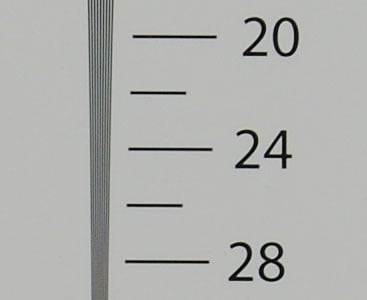 | 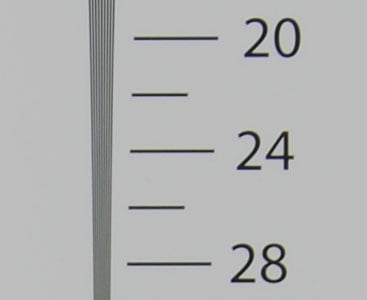 | |
2400 lpph, DX 16-85mm VR at 35mm, f8, 100 ISO | 2300 lpph, DX 18-105mm VR at 35mm, f8, 100 ISO |
Vertical resolution using Nikon D90 in RAW
Nikkor DX 16-85mm VR with Nikon D90 | Nikkor DX 18-105mm VR with Nikon D90 | |
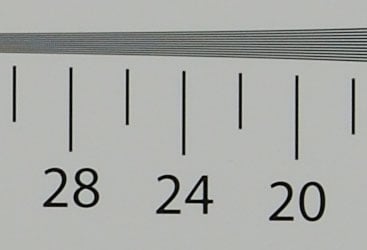 | 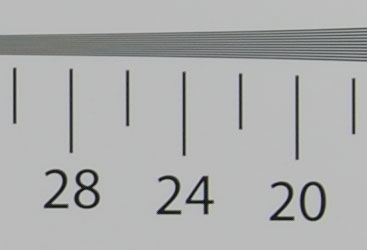 | |
2450 lpph, DX 16-85mm VR at 35mm, f8, 100 ISO | 2400 lpph, DX 18-105mm VR at 35mm, f8, 100 ISO |
Nikkor DX 16-85mm VR Geometric distortion
To measure the Nikkor DX 16-85mm VR’s geometric distortion, we photographed a chart consisting of a grid pattern with the lens set to its shortest and longest focal lengths at an aperture of f8. The images were shot in RAW mode to avoid any in-camera corrections, then analysed with Imatest using 5th Order line calculation, and the full areas presented here at a reduced resolution. Smaller percentages are better. Results for rival lenses are shown at the bottom of this page.
With the Nikkor DX 16-85mm VR zoomed-out, barrel distortion was measured at 5.32%. This is roughly similar to the distortion measured on the DX 18-70mm, DX 18-105mm VR, DX 18-135mm and DX 18-200mm VR when all were zoomed-out, although the DX 18-55mm VR kit lens manages to get away with better figures. So far so similar, but remember the DX 16-85mm VR is zooming wider than the others mentioned here, which often results in greater geometric distortion – it’s good to see it’s no worse than most of the other Nikkor DX general-purpose lenses then. When zoomed-into 85mm, the DX 16-85mm VR exhibited pincushion distortion at 0.907%. While you can visibly see the lines in the graph bend inwards in the image above, it’s actually to a lesser degree than many of the other lenses shown here including the DX 18-105mm VR, DX 18-135mm and DX 18-200mm VR, although the latter comes closer. Once again the DX 18-55mm VR kit lens performs best in the group in this test with just 0.17% pincushion distortion when zoomed-in, although to be fair it does also have the shortest optical range. The earlier DX 18-70mm also performs quite well in terms of low distortion with a figure of 0.59% when zoomed-in, although again it has a lower range than most of the others. So if you were to switch to the DX 16-85mm VR from the DX 18-55mm VR kit lens or the DX 18-70mm, you may notice greater geometric distortion, especially when zoomed-in, but if you’re coming from the DX 18-105mm VR or DX 18-135mm you’ll enjoy a small benefit at longer focal lengths. The most impressive lens in terms of low distortion here is the DX 18-55mm VR kit lens, although again it has the smallest optical range. Now let’s see how the lenses compare in terms of light fall-off in the corners in our Nikkor DX 16-85mm VR vignetting results. Nikkor DX 16-85mm VR Geometric distortion compared to other lenses (smaller percentages are better)
| |||||||||||||||||||||||||||||||||||||||||||||||||||
Nikkor DX 16-85mm VR Vignetting / Light fall-off
With the DX 16-85mm VR zoomed-out to its widest 16mm focal length and with the aperture wide open at f3.5, light falls-off in the corners to an average of 59% of the centre measurement. This is roughly similar to the DX 18-200mm VR, but noticeably superior to the DX 18-135mm, DX 18-55mm VR and DX 18-70mm when all are zoomed-out. Interestingly the best result here is earned by the D90’s DX 18-105mm VR kit lens which scored 67.7% when zoomed-out. When zoomed-into 85mm at f5.6, light falls-off in the corners to an average of 78.2% of the corner measurement. This is the first ace for the DX 16-85mm VR, scoring comfortably higher than any of the other lenses here. The DX 18-200mm VR super-zoom comes closest at 73.4%, but there’s a decent gap between them and the other models, especially the older DX 18-135mm and DX 18-70mm which scored 58.5% and 55.4% respectively. So a good result here for the DX 16-85mm VR in terms of light fall-off which is minimal across the focal range, and easy to correct if desired. That’s enough for our formal tests now, so let’s check out some more real-life sample images in our Nikkor DX 16-85mm VR Gallery.
Nikkor DX 16-85mm VR Vignetting / Light fall-off compared to other lenses (bigger percentages are better)
| |||||||||||||||||||||||||||||||||||||||||||||||||||
